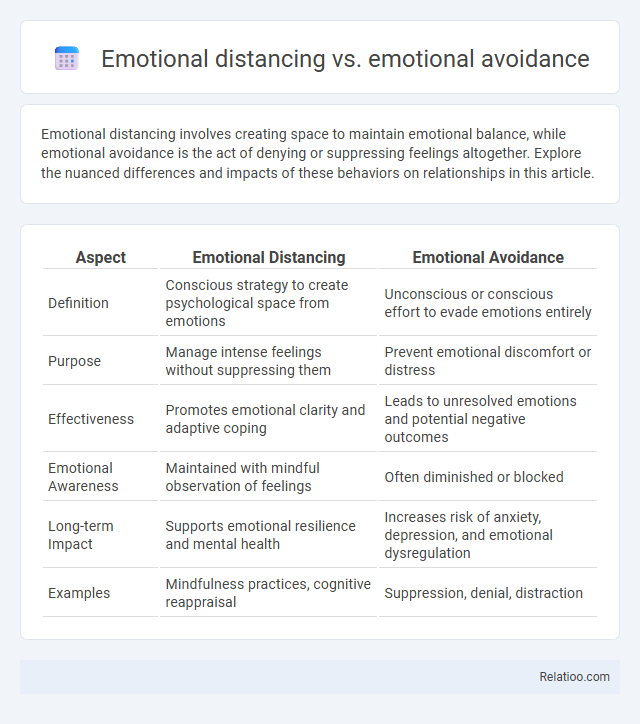Emotional distancing involves creating space to maintain emotional balance, while emotional avoidance is the act of denying or suppressing feelings altogether. Explore the nuanced differences and impacts of these behaviors on relationships in this article.
Table of Comparison
| Aspect | Emotional Distancing | Emotional Avoidance |
|---|---|---|
| Definition | Conscious strategy to create psychological space from emotions | Unconscious or conscious effort to evade emotions entirely |
| Purpose | Manage intense feelings without suppressing them | Prevent emotional discomfort or distress |
| Effectiveness | Promotes emotional clarity and adaptive coping | Leads to unresolved emotions and potential negative outcomes |
| Emotional Awareness | Maintained with mindful observation of feelings | Often diminished or blocked |
| Long-term Impact | Supports emotional resilience and mental health | Increases risk of anxiety, depression, and emotional dysregulation |
| Examples | Mindfulness practices, cognitive reappraisal | Suppression, denial, distraction |
Understanding Emotional Distancing
Emotional distancing involves creating a healthy space from overwhelming feelings to maintain clarity and emotional well-being, whereas emotional avoidance reflects a refusal to acknowledge or process emotions, often leading to unresolved issues. Understanding emotional distancing helps individuals recognize the difference between protective separation and harmful suppression, promoting emotional regulation without detachment. Studies highlight that effective emotional distancing enhances resilience and interpersonal relationships by fostering mindful engagement rather than complete withdrawal.
Defining Emotional Avoidance
Emotional avoidance refers to consciously or unconsciously steering clear of feelings, situations, or triggers that evoke emotional discomfort, which can hinder your ability to process and resolve inner conflicts effectively. Emotional distancing involves creating a psychological barrier or detachment from intense emotions to maintain stability, often seen in relationships or stressful scenarios without fully disconnecting. Understanding the nuances between emotional avoidance and distancing is crucial for developing healthier coping mechanisms and emotional resilience.
Key Differences Between Emotional Distancing and Avoidance
Emotional distancing involves creating a conscious boundary to protect yourself from overwhelming feelings, while emotional avoidance refers to the unconscious act of ignoring or suppressing emotions altogether. Your awareness plays a crucial role in emotional distancing, as it allows you to maintain a healthy separation without disconnecting entirely, unlike avoidance which often leads to unresolved emotional issues. Recognizing these key differences helps in developing healthier emotional regulation strategies and improving overall mental well-being.
Psychological Reasons Behind Emotional Distancing
Emotional distancing involves creating a psychological space to manage stress or protect oneself from emotional overload, often as a coping mechanism rooted in childhood experiences or trauma. Emotional avoidance, distinct yet related, entails consciously steering clear of emotional triggers to prevent discomfort or pain, which can stem from anxiety disorders or past relational wounds. Psychological reasons behind emotional distancing include fear of vulnerability, unresolved attachment issues, and the need for self-preservation in the face of emotional threats.
Why People Resort to Emotional Avoidance
People often resort to emotional avoidance to protect themselves from overwhelming feelings or painful experiences that feel too difficult to process. Emotional avoidance can create a temporary sense of safety by pushing uncomfortable emotions away, which differs from emotional distancing that involves purposely creating space in relationships to maintain balance or boundaries. Your understanding of these coping mechanisms helps in recognizing when avoidance may hinder emotional growth and healing.
Effects of Emotional Distancing on Relationships
Emotional distancing often leads to decreased intimacy and trust, causing partners to feel disconnected and misunderstood. Compared to emotional avoidance, which involves ignoring feelings, distancing creates a barrier that impedes effective communication and emotional support. Persistent emotional distancing can result in relationship dissatisfaction, increasing the risk of conflict, withdrawal, and potential breakdown over time.
Negative Impacts of Emotional Avoidance
Emotional avoidance involves consciously suppressing feelings, which can lead to increased stress, anxiety, and weakened relationships due to unresolved issues. Unlike emotional distancing, which maintains awareness but creates space from intense emotions, avoidance prevents emotional processing, often resulting in long-term psychological harm. Your inability to confront emotions may hinder personal growth and exacerbate mental health challenges.
Signs You Might Be Emotionally Distancing or Avoiding
Signs you might be emotionally distancing include feeling detached from loved ones, avoiding deep conversations, and consistently prioritizing solitude over social interaction. Emotional avoidance often manifests as dismissing or suppressing feelings, unwillingness to acknowledge emotional pain, and diverting attention away from situations that provoke vulnerability. Recognizing patterns such as reluctance to engage emotionally, frequent withdrawal during conflicts, and heightened discomfort with intimacy are key indicators of both emotional distancing and avoidance behaviors.
Healthy Alternatives to Emotional Distancing and Avoidance
Emotional distancing and emotional avoidance both involve creating barriers to feelings but differ in intent; distancing maintains awareness of emotions while avoidance attempts to ignore or suppress them. Healthy alternatives to these behaviors include practicing mindful self-reflection, engaging in open communication to express your feelings, and developing emotional resilience through therapy or journaling. These strategies help you process emotions constructively, fostering deeper connections and mental well-being.
Steps to Foster Emotional Connection
Emotional distancing involves creating healthy boundaries to maintain individuality while staying connected, achieved by practicing self-awareness and open communication. Emotional avoidance, characterized by suppressing feelings to escape discomfort, can be mitigated through gradual emotional exposure and seeking supportive environments. To foster emotional connection, prioritize empathy, active listening, and vulnerability to build trust and deepen relationships.

Infographic: Emotional distancing vs Emotional avoidance
 relatioo.com
relatioo.com